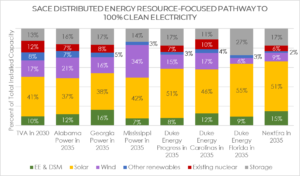
The Biden Administration announced last year the goal of eliminating carbon emissions from the electricity sector by 2035.
For the Southeast, this would require a rapid shift in infrastructure and policies. But the region has multiple pathways to achieve totally clean power by then, according to a new report from the Southern Alliance for Clean Energy.
“It is absolutely possible to get to 100% clean electricity, and we even have options to how we get there,” said Maggie Shober, a study author and researcher at SACE. “The biggest key takeaway is we need to start right away.”
 Southern Alliance for Clean Energy
Southern Alliance for Clean Energy The Southern Alliance for Clean Energy demonstrates one possible energy mix for utilities in the Southeast to achieve 100% carbon-free power by 2035.
The report lists several components required to meet the proposed deadline.
Southern utilities would need to install large-scale solar, wind farms and batteries, and use existing hydro and nuclear energy. Then, they’d need to share resources through strategic transmission connections, such as connecting to wind farms in the West, in other parts of the region or offshore.
This transition would also require major investments in energy efficiency and customer-sited solar, which could account for as much as a third of all electricity needs by 2035. Traditional energy efficiency programs include replacing outdated heating and cooling units, weatherizing homes and shifting energy usage during peak times of the day or week.
One way to kickstart this transition is a clean electricity standard — a federal policy that mandates a specified percentage of net-zero carbon power.
 National Conference for State Legislatures
National Conference for State Legislatures A map of the U.S. with states colored by whether they have required or voluntary renewable portfolio standards, or no standards at all
In the U.S., 37 states already have required or voluntary clean power requirements, or renewable portfolio standards. Nine states in the Southeast do not have standards, according to the National Conference for State Legislatures.
In Tennessee, hydroelectric accounted for 12% of the state’s total power generation in 2019 and almost 90% of the its renewable energy that year, according to the U.S. Energy Information Administration.
At the Tennessee Valley Authority, hydroelectric power accounts for 11% of the utility’s power mix, and nuclear accounts for 39%. Between this carbon-free generation, TVA’s sprawling transmission and a high potential for energy efficiency, the utility could reach 100% clean power ahead of the deadline, the report says.
“We actually think TVA can decarbonize by 2030,” Shober said. “There are a lot of TVA customers out there using more electricity than they need to be using. TVA can invest in helping them use less. It reduces their bills and reduces the amount of energy that TVA needs to generate.”
Additionally, Shober says, because TVA is federally owned, there would be less red tape to comply with a federal plan.

